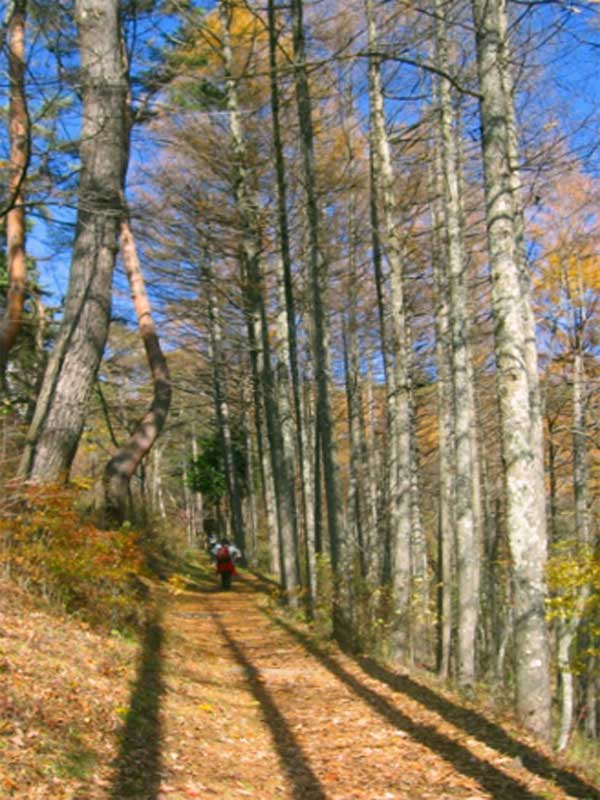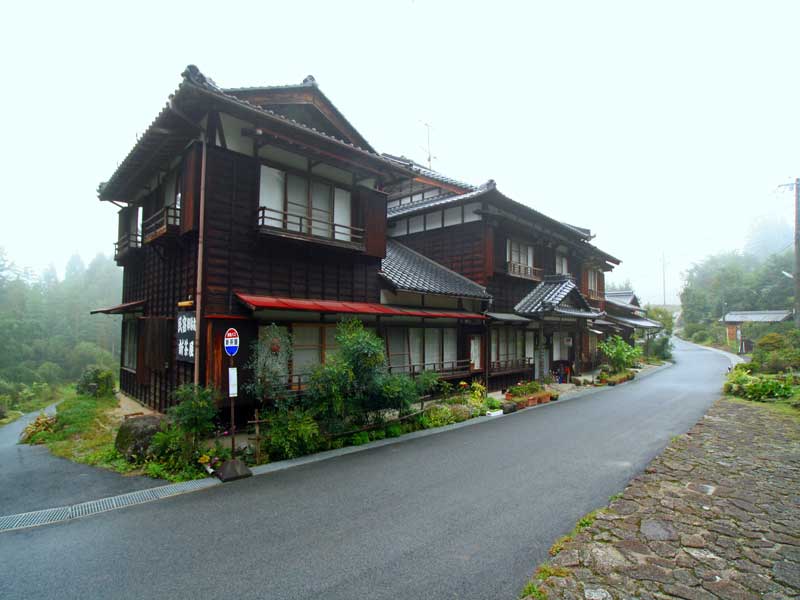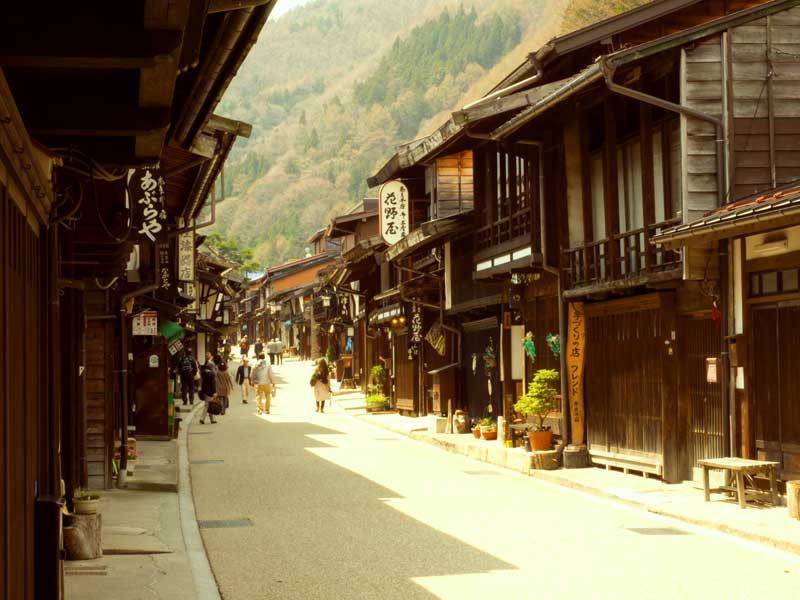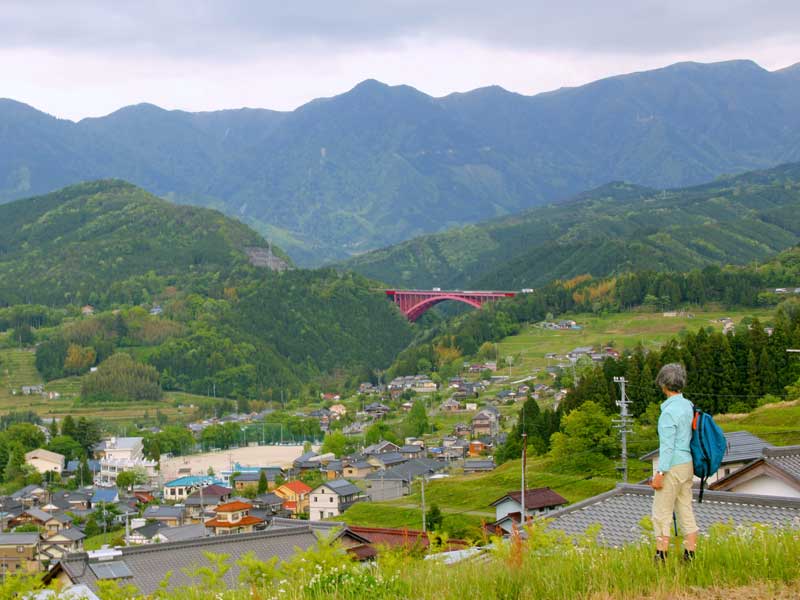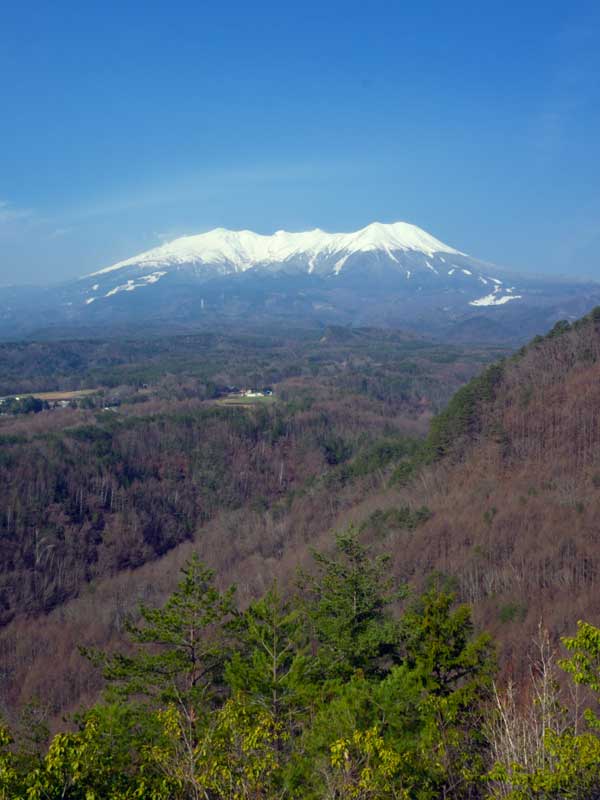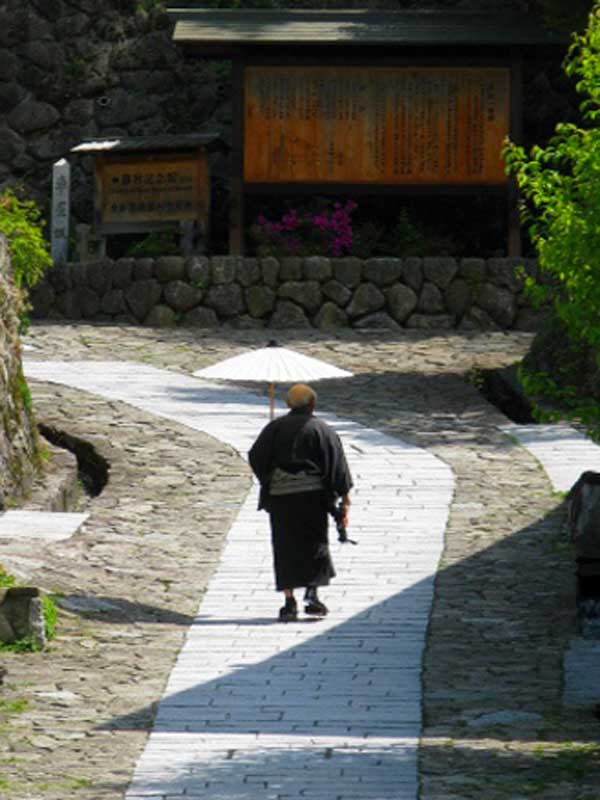A self-guided walking tour along a continuous route through central Japan.
Self-guided version of Walk Japan’s pioneering Nakasendo Way. An excellent introduction to Japan following the mid-section of a historic road in central Japan; great walking through rural, hilly countryside with expansive views; atmospheric traditional inns, local cuisine and a wealth of interest.
March - June & September - November.
The Nakasendo Wayfarer is a 7-day, 6-night tour starting in Ena, near Nagoya, and finishing in Tokyo. The Nakasendo Wayfarer Pre-Tour Extension is a 2-night, 3-day optional prologue tour addition starting in Inuyama, also close by Nagoya, that visits the old post-towns of Mitake, Hosokute, and Okute before arriving at Ena for onward journey on the Nakasendo Wayfarer Tour to Tokyo. Tour accommodation is in Japanese inns and hotels. Please read more on accommodation here. For more information please contact us.
Walk Japan’s Nakasendo Wayfarer is an unescorted walking tour exploring the most picturesque and evocative sections of the historic Nakasendo Way between Kyoto and Tokyo. This tour, which can be comfortably undertaken independently, is based on Walk Japan’s extensive expertise derived from pioneering guided walking tours of the Nakasendo Way and provides you with a unique, intimate experience of Japan and its people.
The Nakasendo Wayfarer takes you on an exploration of Japan following in the footsteps of the feudal lords, imperial princesses, samurai, artisans, merchants, entertainers and villagers, who once made their way along this historic highway. It visits the delightful Kiso Valley and its picture-postcard old post-towns, including Magome, Tsumago and Narai; Japan’s towering Southern Alps; and Karuizawa, at one-time a post town and now an upmarket mountain resort, before ending in the modern metropolis of Tokyo. The Tour includes an excursion along the old Hida Kaido, a spur road to the Nakasendo Way, to take you to Kaida Kogen, a gracefully beautiful plateau set against the dramatic backdrop of imposing Mt. Ontake-san, a volcano. With its heyday in the 17th Century, the Nakasendo Way has long been overlooked and today, as a consequence, its provides us with a fascinating journey not only through scenic countryside but also the history of Japan, its society and rural life.
The Japanese are a delightful, friendly and helpful people. You will have ample opportunity to meet and share in the stories of those who still live and work along the route as you walk in the footsteps of the travellers of old along country roads and forest trails; past paddy fields and remote farmhouses; over passes and through old post towns. Some of the post towns, which line the old highway, have been providing respite and refuge for centuries and still retain a charm of another age, the Edo Period (1603–1868) and the days of the samurai. Here we find the traditional wayside inns that provide you with friendly and atmospheric overnight accommodation at the end of a day’s walk. In an ambience reminiscent of the scenes found in the great artist Hiroshige’s woodblock prints, you relax in distinctively Japanese surroundings of shoji sliding paper screens and tatami straw mat flooring. Japanese baths, sourced in some inns from onsen thermal hot springs, are an excellent way to relax and luxuriate in at the end of the day. Your hosts provide you with a warm welcome and feasts of home-cooked, regional cuisine, many of the ingredients of which they will have grown or sourced from the surrounding forests themselves.
The Nakasendo Wayfarer starts in either Ena or, if you add the optional Pre-Tour Extension tour, Inuyama. Both towns are easily reached by train from Nagoya, which itself is easily reached by Shinkansen bullet train from Japan’s major airports. The Nakasendo Wayfarer includes easy-to-follow, detailed instructions on how to join and prepare for the tour. The daily walking distance is between 10–24kms (6.2–14.9 miles) and options may be provided to lengthen or shorten each day’s itinerary to suit your energy levels. There are several passes to be negotiated along the route but these can be climbed at a comfortable pace and usually take less than 30 minutes to reach the top. Your main baggage, sent ahead by courier, is with you each evening for every night of the tour except one. On one morning, a taxi is reserved to transfer you to the start of a more remote walking path.
What is included?
A pre-tour pack. Each pack should answer most, if not all, of the questions you may have and includes such details as how to prepare for your Wayfarer Tour, how to travel from your arrival point in Japan to the accommodation on the tour's first night, an accommodation list, and travel advice. Upon receipt of a completed manifest form, your pre-tour pack will be made available for online viewing approximately two months prior to the start date of your tour. It can also be downloaded as a PDF file for offline use.
A Wayfarer Route Booklet. This is provided on arrival at your first night’s accommodation, and is an easily portable booklet. This includes detailed walking directions and logistical information, including maps, photographs and site-specific information such as lunch/cafe recommendations, museum/gallery recommendations and historical points of interest. A rain-resistant pouch and shoulder strap are also provided for ease of carrying the booklet while walking.
Click here for a sample of the Wayfarer booklet.
6 nights' accommodation, 6 breakfasts and 6 dinners. (Pre-Tour Extension: 2 nights’ accommodation, 2 breakfasts, 1 lunch and 2 dinners).
Main baggage transfer between your accommodation.
One reserved taxi transfer to the start of a walking path, which is otherwise inaccessible by public transport. One private vehicle transfer to catch a timely morning train to the start of the day's walk.
In-country (Japan), 24-hour English-language emergency support.
What is not included?
Not included are flights, all lunches and drinks with meals, taxi transfers other than those noted above.
Please note that Wayfarer self-guided tours sometimes require transfers by public buses and/or trains that are not included in the tour price. This is either because it is not possible to reserve them in advance or to allow maximum flexibility for tour participants. Please contact us for further details.
Please see the Itinerary for this tour by clicking on the button found further up this page.
Further information about the history of the Nakasendo Way is available at our complementary website Nakasendo Way: A Journey to the Heart of Japan.

Please note that on Day 6 (or Day 8 in the case of the extension), your main baggage will be shipped in advance overnight to your post-tour accommodation. On this day you will need to carry all items you require overnight and your daypack should be sufficiently large to accommodate these items.
Day 1 Ena
The tour itinerary starts upon check-in at your accommodation in Ena. Once a post town on the Nakasendo Way, it is now a small regional town and provides a convenient point to begin your tour. Your stay overnight here is in a ryokan, a traditional Japanese inn. Aside the Nakasendo Way, the inn was founded in 1624 and your hostesses comprise three generations; respectively the thirteenth, fourteenth and fifteenth of the original innkeeper’s family line.
An early arrival in Ena is recommended to explore the town and, opening hours permitting, allow a visit to the informative and entertaining Hiroshige Museum of Art. Dedicated to the famous woodblock print artist, who depicted many scenes of Edo Japan including all the post towns of the Nakasendo Way, the museum displays many of his prints and provides a hands-on exhibition of print-making. Be sure to make it back to your inn in time for dinner, the first feast of your tour.
Accommodation: Traditional Japanese inn.
Meals: Dinner provided.
Total walking: N/A.
Total elevation gain: N/A.
Day 2 Ena – Nakatsugawa – Shinchaya
After breakfast, continue along the Nakasendo Way. Just over 12km distant along largely quiet country lanes, over gently undulating terrain, is Nakatsugawa. En route are many of the wayside temples, shrines and stone statues and markers that are typical of all the ancient roads of Japan. The scenery changes from town to rural and back as you approach Nakatsugawa. On a clear day, along the way you may see in the far distance Mt. Ontake-san, the volcano that becomes a near neighbour on Day 4.
Nakatsugawa has many different restaurants to enjoy lunch at, including an excellent one that serves the local delicacy, eel. A large supermarket also provides an interesting look at daily Japanese life and a wide variety of foods to select from for a picnic.
From Nakatsugawa, the route is akin to a helter-skelter, combining a series of steep climbs and descents. This afternoon, the scenery opens up for views across valleys before the route follows traditional ishidatami stone paving through a forest. En route, you pass through the quiet post town of Ochiai, which still retains its honjin top-class inn. A rare feature, it has remarkably survived into the modern age, though unfortunately is no longer in business. At the top of the final climb appears your inn, a pretty establishment in an idyllic rural setting. Inside a warm welcome awaits you from the host and hostess, as does a refreshing bath to relax in. You will also find your main luggage, which was brought here from Ena by vehicle. Dinner is composed of many dishes of local delicacies, both grown and caught by your host. Afterwards an evening stroll along the road in traditional geta wooden clogs is recommended.
Accommodation: Traditional Japanese inn.
Meals: Breakfast & dinner provided.
Total walking: 18km (11 miles).
Total elevation gain: 425m (1,394ft).
Day 3 Shinchaya – Magome – Tsumago
Following breakfast, the first half hour of walking takes you through bucolic surroundings of paddy fields, set against a backdrop of mountains, and past farmhouses with neatly tended gardens strung along your route. Magome, a post town set unusually on the side of a mountain, is your initial destination this morning. The first of several elegant villages you visit on this tour, it was the birthplace of Shimazaki Toson, Japan’s first modern novelist and author of Before the Dawn. His novel eloquently describes Japan's transition from feudal to modern society in his home town.
Today, few of its many visitors stay in Magome but there are plenty of cafés to relax in and shops to browse through. Enjoy expansive views across to Mt. Ena before continuing on the Nakasendo Way up the appropriately named Magome Pass.
From the top, your route now gently meanders downhill on a forest path, through cedar forests, past clear running mountain streams and waterfalls. An Edo-period teahouse in a clearing in the forest still exists much as in days of old and provides a picturesque place to rest and take refreshment. Eventually, you reach Tsumago post town. The inhabitants of Tsumago take great pride in their town and preserve it much as it would have looked like in the Edo Period. Tsumago is delightful to stroll through and the post town’s high class inn, once reserved only for the top samurai, is now a museum providing an informative look at life here over the ages. Optional visit to a local onsen thermal hot spring is followed by dinner at your inn just outside Tsumago in a lovely hamlet aside a river.
Accommodation: Traditional Japanese inn.
Meals: Breakfast & dinner provided.
Total walking: 10km (6.2 miles).
Total elevation gain: 461m (1,512ft).
Day 4 Tsumago – Nagiso – Kiso-Fukushima
A morning walk of approximately 6km from Tsumago to Nagiso follows the old highway through picturesque hamlets and fields. In the late morning, you can take one of two routes to Kiso-Fukushima, your final destination today.
Course A, the first route, is a long walk of approximately 15km up and over the Nenoue Pass, through scenic mountain countryside, before descending to Nojiri. From here, trains depart for Kiso-Fukushima.
Course B allows for a relaxed day by taking the train from Nagiso to Kiso-Fukushima, allowing you ample time to explore both Nagiso and Kiso-Fukushima. The former has an intriguing footbridge spanning the Kiso River and a small museum, which was once home to Momosuke, who built the bridge, and his partner Sadayakko, one time geisha and a colourful character. She travelled to the USA and Europe and, creating a sensation, appeared on the front of Harper’s Bazaar magazine in 1900. Kiso-Fukushima has an excellent soba buckwheat noodle restaurant, a famous lacquer shop and a Buddhist temple containing one of Japan’s largest Zen rock gardens.
Your accommodation tonight is in a traditional inn in the centre of town. Onsen baths and a sumptuous evening meal also await you here.
Accommodation: Traditional Japanese inn with onsen hot spring baths.
Meals: Breakfast & dinner provided.
Total walking: Course A: 23km (14.3 miles); Course B: 8-10km (5-6.2 miles).
Total elevation gain: Course A: 714m (2,340ft); Course B: 107m (351ft).
Day 5 Kiso-Fukushima – Kaida Plateau
In a deep valley and at the confluence of two rivers, Kiso-Fukushima was an ideal strategic defensive location known throughout the land for its sekisho checkpoint, which controlled all traffic along the Nakasendo Way. A reconstruction of the checkpoint provides interesting insights into its use by the Shogun to maintain his power.
A reserved taxi transfers you from your inn to the Karasawa-no-taki, a towering waterfall, and the beginning point of today’s walk. From here a forest trail takes you over the Jizo Pass and down to the beautiful Kaida Plateau in time for lunch. Restaurants include a café, run by a lovely couple retired here from city life, and a soba noodle restaurant. Your route across the Plateau passes through a horse ranch, which specialises in breeding the stocky local Kiso horse. From here, a bus to your inn or, for the more energetic, an afternoon walk up and over the Nishino Pass, which on a clear day, offers spectacular views over the Plateau to imposing Mt. Ontake-san and Japan’s Central and Northern Alps. The descent leads quickly to your inn, another family-run establishment with onsen baths serving another sumptuous dinner.
Accommodation: Traditional Japanese inn with onsen hot spring baths.
Meals: Breakfast & dinner provided.
Total walking: 10-14km (6.2-8.7 miles).
Total elevation gain: 673m (2,200ft).
Day 6 Kaida Plateau – Narai – Karuizawa
Following breakfast, a reserved vehicle transfers you to the station, where a train ride brings you to the start of today’s walk at Yabuhara post town. From here a 9km (5.6 mile) walk through forests, up and over the Torii Pass, before descending into Narai, another scenic post town. Narai is known for its unique architecture, boxwood combs and lacquer ware. The town’s pleasant ambience is matched by the congeniality of it townsfolk. Transfer from here by local train and shinkansen bullet train to arrive in the early evening at your accommodation in Karuizawa. Mineral-rich baths and another feast await you here.
Accommodation: Traditional Japanese inn with onsen hot spring baths.
Meals: Breakfast & dinner provided.
Total walking: 9km (5.6 miles).
Total elevation gain: 373m (1,220ft).
Day 7 Karuizawa – Yokokawa – Tokyo
Your walk this morning is a gentle climb consisting of many switchbacks through beautiful maple forest to the top of the Usui Pass. From here on a clear day, views are afforded of yet another volcano, Mt. Asama. After visiting the Kumano Kotai Jinja, a shrine at the top of the pass dedicated to the founding gods of Japan, a long descent along a forest trail brings you to Yokokawa station. Your walking course ends here, but we provide train transfer details to independently reach Tokyo and visit Nihonbashi Bridge, the official start/end point of the Nakasendo Way.
Accommodation tonight is not included in this tour but we are happy to provide recommendations in Tokyo if required.
Accommodation: N/A.
Meals: Breakfast provided.
Total walking: 16km (10 miles).
Total elevation gain: 438m (1,440ft).
This itinerary is subject to change.
Further information about the history of the Nakasendo Way is available at our complementary website Nakasendo Way: A Journey to the Heart of Japan.
The optional Pre-Tour Extension for the Nakasendo Wayfarer Self-guided Tour is ground-only, beginning in Inuyama and ending at the start of the standard itinerary in Ena. This extension cannot be undertaken separately from the standard itinerary. Prior to the tour, Walk Japan will provide detailed instructions for travelling to your accommodation in Inuyama from Osaka’s Kansai (KIX) Airport, and Tokyo’s Narita (NRT) and Haneda (HND) Airports.
Day 1 Inuyama
Your tour begins on arrival in Inuyama, a compact and atmospheric town, that is famed for its castle keep, which is one of only five designated as National Treasures in Japan. We recommend arriving by mid-day so as to leave enough time to enjoy Inuyama’s sites of interest along our recommended stroll.
Your accommodation, which is in the centre of town, boasts onsen hot spring baths. Relax in the soothing waters before enjoying a sumptuous dinner of local delicacies.
Accommodation: Hotel with onsen hot spring baths.
Meals: Dinner provided.
Total walking: N/A.
Total elevation gain: N/A.
Day 2 Inuyama – Mitake – Hosokute
After breakfast in your accommodation, explore more of Inuyama before transferring by train to the start of your walk today from Mitake, the 49th of 69 post-towns that were strung out along the entire 554km Nakasendo Way from Tokyo to Kyoto. Mitake includes some beautiful period buildings for you to explore before striding out on the old highway through rolling farming and forested countryside to your evening’s destination, the neighbouring post-town of Hosokute.
Stretches of the path still retain the original ishidatami stone paving, which was laid to assist on what would otherwise be tricky uphill climbs. Aside your way are dotted farmhouses and numerous wayside shrines that have afforded spiritual protection to passersby for centuries. En route, a delightful and popular café, specialising in home-made herbal teas and cake, is a modern take on the many teahouses along the Nakasendo Way that once catered to travellers of old.
Your atmospheric accommodation tonight, once a waystation for imperial couriers, is undoubtedly one of the oldest structures still operating as an inn in all of Japan. The host and hostess are locally renowned for their hospitality and delicious evening meal.
Accommodation: Japanese inn.
Meals: Breakfast & dinner provided.
Total walking: 12km (7.5miles).
Total elevation gain: 465m (1,525ft).
Day 3 Hosokute - Okute - Ena
Following an early breakfast, continue along the Nakasendo Way to arrive at Ena by mid-afternoon. An initial stretch of quiet country road leads to a gentle ascent through forest on a section of the highway that lay forgotten for decades. It is said to incorporate the longest continuous stretch of original ishidatami stone paving in Japan. After negotiating a low pass, descend to Okute, another one-time post-town and now a delightful hamlet. Just past the entrance to the town, stands a giant cedar tree. Of immense girth, it is estimated to be 1,200 years old and long been venerated as a kami, a Shinto deity.
Beyond Okute, is a section of the old highway known as the Jusan-toge, or Thirteen Passes. Contrary to the name, however, it is actually gently undulating terrain without any significant climbs. This section of the highway dates back to the 7th Century, when the valleys on either side remained uncultivated and virtually impassable. As you emerge from forests the roar of traffic on a modern expressway signals your arrival on the outskirts of Ena. Time here to visit a charming museum dedicated to woodblock artist Utagawa Hiroshige before retiring to your accommodation.
Accommodation: Japanese inn.
Meals: Breakfast & dinner provided.
Total walking: approximately 22km (13.7 miles).
Total elevation gain: 346m (1,135ft).
This itinerary is subject to change.
Further information about the history of the Nakasendo Way is available at our complementary website Nakasendo Way: A Journey to the Heart of Japan.
Transportation costs are not included in the cost of the Nakasendo Wayfarer.
The airport closest to the tour's start points is Nagoya’s Central Japan Airport. The journey is also easily made from Osaka’s Kansai International Airport and Tokyo’s Narita and Haneda International Airports.
-----
FROM NAGOYA’S CENTRAL JAPAN INTERNATIONAL AIRPORT (NGO), Meitetsu trains depart for Meitetsu Nagoya Station. For Ena, change to the neighbouring JR Nagoya Station for onward journey on the Chuo Line to Ena. For Inuyama, continue on the Meitetsu network to Inuyama. The total journey is approximately 1 hour 40 minutes.
-----
FROM OSAKA’S KANSAI INTERNATIONAL AIRPORT (KIX), JR Haruka Express trains depart for Shin-Osaka Station. Transfer here to the shinkansen bullet train for Nagoya, where a further transfer is required to the JR Chuo Line for Ena, or to the Meitetsu network for Inuyama. The total journey is approximately 3 hours 15 minutes.
-----
FROM TOKYO’S HANEDA AIRPORT (HND), Keikyu trains depart for Shinagawa Station. Transfer here to the Tokaido Shinkansen bullet train for Nagoya, where a further transfer is required to the JR Chuo Line for Ena, or to the Meitetsu network for Inuyama.The total journey is approximately 3.5 hours.
-----
FROM TOKYO’S NARITA AIRPORT (NRT), JR Narita Express trains depart for Tokyo Station. Transfer here to the Tokaido Shinkansen bullet train for Nagoya, where a further transfer is required to the JR Chuo Line for Ena, or to the Meitetsu network for Inuyama. The total journey is approximately 4 hours 10 minutes.
The pre-tour pack includes detailed instructions, including a map, for travel to the accommodation at the start of the tour.
Tour participants are advised not to book themselves out on a flight on the final day of the tour, as it concludes in the evening in Tokyo.




